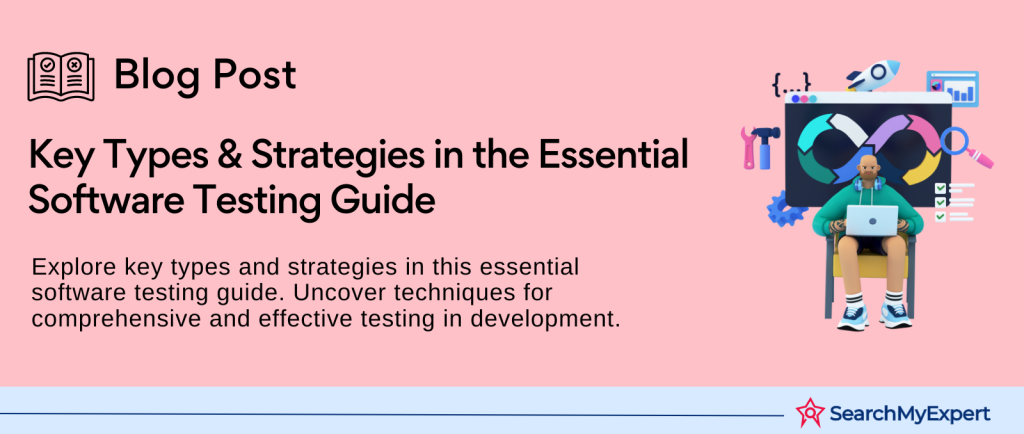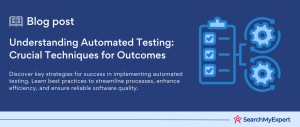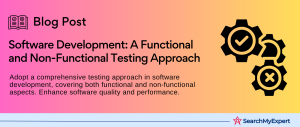The Essential Guide to Software Testing: A Deep Dive into Quality and Reliability
Importance of Software Testing
In today’s digital age, software has become the backbone of businesses, governments, and our daily lives. The reliability, functionality, and safety of software systems are paramount, making software testing an indispensable part of the development process. Software testing goes beyond just identifying bugs before a product goes live. It is about ensuring software quality, reliability, and user satisfaction, which are crucial for the success and longevity of software applications.
Why is software testing crucial? Firstly, it ensures that the software meets its intended requirements and performs as expected in real-world scenarios. This is vital for maintaining user trust and satisfaction. Secondly, software testing identifies potential vulnerabilities and security risks, safeguarding sensitive data and preventing costly breaches. Lastly, it helps in maintaining a competitive edge by ensuring that the software is of the highest quality, thereby enhancing user experience and engagement.
Software testing is not just a phase but a continuous process that accompanies a software project from its inception to delivery and maintenance. It provides a safety net that allows developers to make changes and updates with the confidence that those changes won’t inadvertently introduce new issues or negatively impact the user experience.
Basic Testing Concepts
Understanding the basic concepts of software testing is foundational for grasping the different approaches and methodologies used in ensuring software quality. Here, we introduce key terms that form the core of software testing knowledge.
Testing Levels:
Software testing is organized into different levels, each targeting a specific layer of the software system. The main levels are:
- Unit Testing:
Focuses on testing individual components or modules of the software to ensure they work correctly in isolation. - Integration Testing: Tests the interfaces and interactions between integrated components or systems.
- System Testing:
A comprehensive level that tests the complete and integrated software product to verify that it meets specified requirements. - Acceptance Testing: Conducted with the involvement of the end-users, it ensures the software meets their needs and expectations.
Testing Types:
There are various testing types, each designed to identify specific kinds of issues or to evaluate different aspects of the software:
- Functional Testing: Assesses the software’s functionality to ensure it behaves as expected.
- Non-Functional Testing:
Evaluates the software’s performance, usability, reliability, and security aspects. - Manual Testing: Involves human testers to explore and interact with the software to find issues.
- Automated Testing:
Uses software tools to run tests automatically, which is efficient for repetitive tasks and regression testing.
Testing Techniques:
To effectively test software, various techniques are employed:
- Black Box Testing:
Tests the functionality without knowledge of the internal workings of the application. - White Box Testing:
Involves testing internal structures or workings of an application, often done at the unit testing level. - Grey Box Testing: A combination of both black box and white box testing methodologies, providing a more comprehensive testing approach.
Functional Testing: Ensuring Software Meets Its Purpose
Definition of Functional Testing
Functional testing stands as a cornerstone in the realm of software quality assurance, focusing meticulously on verifying that a software application operates in alignment with its specified requirements and functionality. This testing approach delves into the application’s features and operational behavior, ensuring that every input yields the expected outcome, and that all functionalities are executed as intended. Unlike non-functional testing, which evaluates performance, security, and usability, functional testing zeroes in on the “what” of the application—what the software is supposed to do.
Subtypes of Functional Testing
Functional testing encompasses a spectrum of testing subtypes, each addressing different layers and aspects of the software to ensure comprehensive coverage and quality.
Unit Testing
Unit testing is the bedrock of functional testing, where the smallest testable parts of an application, known as units or components, are tested individually and in isolation. This focus on isolated units allows developers to pinpoint errors at the earliest stages of the development cycle, facilitating quicker fixes and enhancing code quality. Unit tests are typically automated, providing a swift and efficient means to continually verify the functionality of code changes or additions.
Integration Testing
As software systems rarely operate in isolation, integration testing becomes crucial. This testing subtype assesses how well integrated components or systems work together, focusing on the interfaces and data flow between modules. The goal is to uncover any discrepancies, data loss, or bugs that might occur when different parts of the application interact. Integration testing serves as a bridge between unit testing and more comprehensive testing forms, ensuring that the components function cohesively as part of the whole system.
System Testing
Moving beyond individual components and their interactions, system testing evaluates the software application as a complete and integrated entity. This end-to-end testing phase checks the software against its requirements to ensure that all functionalities work in unison, offering a seamless user experience. System testing is crucial for verifying that the software meets its intended specifications and behaves as expected in an environment that mirrors the production setting.
Acceptance Testing
The final frontier in functional testing is acceptance testing, which places the software in the hands of its intended users or stakeholders to verify that it meets their needs and expectations. This user-centric testing phase can include various forms, such as alpha and beta testing, where feedback from actual users plays a pivotal role in fine-tuning the software for release. Acceptance testing validates the software’s functionality, usability, and performance in real-world scenarios, ensuring it delivers value to its end-users.
Non-Functional Testing: Beyond Basic Functionality
Definition of Non-Functional Testing
While functional testing scrutinizes what software does, non-functional testing explores how well the software performs under various conditions, focusing on aspects that enhance the user experience, such as performance, usability, security, and compatibility. This testing domain is pivotal for ensuring the software not only meets its functional requirements but also delivers a reliable, efficient, and secure user experience across diverse environments and platforms. Non-functional testing addresses the software’s operational characteristics, aiming to optimize its behavior in the real world.
The significance of non-functional testing lies in its ability to identify potential bottlenecks and weaknesses that might not be evident through functional testing alone. By rigorously evaluating the software’s performance, usability, security, and compatibility, developers and testers can ensure that the application is robust, user-friendly, and secure from potential threats, thereby enhancing overall software quality and user satisfaction.
Subtypes of Non-Functional Testing
Non-functional testing encompasses several critical subtypes, each focusing on a specific aspect of the software’s performance and behavior.
Performance Testing
Performance testing is crucial for assessing how the software behaves under various load conditions. It aims to identify performance bottlenecks and ensure the software can handle high traffic and data processing demands. Performance testing includes:
- Load Testing: Evaluate the software’s performance under expected user loads.
- Stress Testing:
Determines the software’s threshold by testing it under extreme load conditions. - Spike Testing:
Assesses the software’s ability to handle sudden surges in load.
By simulating different scenarios, performance testing ensures that the software remains responsive, stable, and reliable, providing a seamless user experience even under challenging conditions.
Usability Testing
Usability testing focuses on evaluating how intuitive, user-friendly, and accessible the software is for its intended users. It involves real users interacting with the application to identify any usability issues that could hinder user satisfaction or adoption. Usability testing is key to ensuring that the software not only meets its functional requirements but also offers a pleasant and efficient user experience, encouraging continued use and positive feedback.
Security Testing
In an era where data breaches and cyber threats are prevalent, security testing is indispensable. This subtype involves identifying vulnerabilities, threats, and risks that could compromise the software’s security, data integrity, and user trust. Security testing encompasses various techniques, including penetration testing and vulnerability scanning, to ensure the software is fortified against both known and emerging security threats.
Compatibility Testing
Compatibility testing ensures that the software operates as intended across different environments, including various platforms, browsers, and devices. This testing subtype is critical for verifying that the software offers a consistent user experience, regardless of the user’s choice of technology. Compatibility testing helps identify and rectify issues related to software interoperability, display, and functionality across diverse systems, ensuring broad accessibility and usability.
Expanding the Testing Horizon: Exploring Additional Testing Types
In the vast landscape of software testing, understanding the nuances of each testing type is crucial for ensuring comprehensive quality assurance. Beyond the realms of functional and non-functional testing, there are pivotal testing methodologies designed to refine and reinforce software quality further. Let’s delve into some of these essential testing types, shedding light on their importance and application in the software development lifecycle.
Regression Testing
Regression testing is a critical component of the testing process, designed to ensure that previously fixed bugs remain resolved and that recent code changes have not inadvertently introduced new issues. This type of testing is vital after any modification, update, or addition to the software’s codebase. It serves as a reassurance that the application’s functionality remains intact and that enhancements or fixes have not compromised existing features. Regression testing can be performed manually but is often automated to cover extensive areas of the application efficiently, ensuring high levels of software stability and reliability over time.
Smoke Testing
Often referred to as “sanity testing,” smoke testing is a preliminary testing phase that focuses on verifying the basic, critical functionality of a software application after significant changes, such as new builds or updates. The metaphor here implies that if the software fails this initial test—like a system that “smokes” when turned on—it’s not ready for more detailed testing. Smoke testing aims to quickly identify major flaws that could render the software unusable, ensuring that the core functionalities are operational before proceeding to more exhaustive testing phases. This rapid, high-level testing is crucial for streamlining development and testing cycles, saving time and resources by catching show-stopping bugs early in the process.
Exploratory Testing
Exploratory testing champions a more heuristic and intuitive approach to testing, where testers dive into the software with an open mind and creative thinking to uncover potential issues that formalized test cases might not catch. This type of testing relies heavily on the tester’s experience, skills, and understanding of the software, allowing for a flexible and adaptive testing process. Exploratory testing encourages curiosity and innovation, enabling testers to identify bugs, usability issues, and gaps in the application’s functionality from a user’s perspective. It complements structured testing by bringing a human element into the process, often leading to the discovery of subtle, complex, or unforeseen issues.
Strategizing Software Testing: Tailoring Your Approach
In the intricate process of software development, selecting the most suitable types of testing is a critical decision that can significantly impact the quality, reliability, and market success of the final product. This selection process requires careful consideration of various factors to ensure a balanced and effective testing strategy. Here, we explore key considerations for choosing the right testing types and how combining different testing methodologies can create a robust testing framework.
Considerations for Selecting Testing Types
When determining which testing types to employ, several pivotal considerations come into play, each influencing the direction and depth of the testing process:
- Project Scope and Complexity: The size and complexity of the project are fundamental in deciding the extent and variety of testing required. Larger, more complex projects may necessitate a broader range of testing types to cover all functionalities and potential use cases, including intricate integration and system testing.
- Project Risks:
Identifying and evaluating potential risks associated with the software is crucial. High-risk areas may require more intensive testing focus, such as security testing for applications handling sensitive data or performance testing for high-load systems. - Development Methodology:
The choice of development methodology, such as Agile or Waterfall, can influence the testing approach. Agile methodologies might favor more iterative testing types, like exploratory testing, to align with rapid development cycles, while Waterfall might lean towards comprehensive upfront testing phases. - Resources Available: The resources at your disposal, including time, budget, and expertise, play a significant role in selecting testing types. Automated testing, for instance, may require significant initial investment but can save time and resources in the long run for projects with frequent iterations.
- Stakeholder and User Expectations: Understanding the needs and expectations of stakeholders and end-users is vital. Acceptance testing, for example, ensures the software meets user expectations and requirements, providing a user-centric evaluation of the product’s value.
Combining Testing Types for a Comprehensive Strategy
A holistic testing strategy often involves a blend of different testing types, each contributing unique insights into the software’s quality and performance. Combining testing methodologies enables teams to address a wide array of testing objectives and ensures a thorough evaluation of the software from multiple perspectives.
- Integrating Functional and Non-Functional Testing: While functional testing ensures the software meets its intended requirements, non-functional testing evaluates performance, usability, and other quality attributes. Together, they offer a complete picture of the software’s capabilities and user experience.
- Leveraging Automated and Manual Testing:
Automating repetitive and time-consuming tests can significantly enhance efficiency and coverage. However, manual testing remains invaluable for areas requiring human judgment, such as usability and exploratory testing. A balanced approach leverages the strengths of both to achieve optimal results. - Iterative Testing in Agile Environments:
In Agile projects, combining rapid, iterative testing types like smoke and regression testing with ongoing functional and non-functional testing supports continuous integration and delivery, aligning testing efforts with the development lifecycle. - Risk-based Testing Approach:
Prioritizing testing efforts based on potential risks allows teams to allocate resources effectively, combining targeted testing types like security testing for high-risk components with broader testing strategies for comprehensive coverage.
Mastering the Art of Software Testing
As we conclude our comprehensive exploration into the world of software testing, we’ve delved into the nuances of various testing types, each serving a unique purpose in the quest for flawless software. From ensuring functional requirements are met to assessing the software’s performance, usability, security, and compatibility, the breadth of testing methodologies available equips development teams with the tools needed to craft high-quality software solutions.
Recap of Key Types of Software Testing
We started with functional testing, focusing on verifying that the software performs its intended functions correctly. Subtypes such as unit testing, integration testing, system testing, and acceptance testing each play a critical role in examining different aspects of functionality at various stages of the development process.
Non-functional testing was explored next, emphasizing the software’s operation, including performance under load (performance testing), ease of use (usability testing), security vulnerabilities (security testing), and behavior across different platforms and devices (compatibility testing).
Beyond these foundational types, we highlighted the significance of regression testing to ensure new changes don’t reintroduce old bugs, smoke testing for quick checks on critical functionalities, and exploratory testing for uncovering unexpected issues with a creative and unstructured approach.
The Importance of Continuous Testing
The dynamic and iterative nature of modern software development underscores the importance of continuous testing. Testing is not a phase to be left until the end of the development lifecycle but a continuous process that begins from the initial stages of development and persists through to deployment and beyond. Continuous testing enables teams to identify and address issues early, reduce development costs, and improve software quality, leading to a more reliable and user-friendly product.
Additional Resources for Further Exploration
For those eager to dive deeper into the intricacies of software testing and expand their knowledge and skills, a wealth of resources is available. Whether you’re a beginner looking to understand the basics or an experienced professional seeking to refine your expertise, these resources offer valuable insights and guidance on various testing types and techniques.
Books
- “Software Testing:
Principles and Practices” by Srinivasan Desikan and Gopalaswamy Ramesh – A comprehensive guide covering fundamental concepts, strategies, and case studies in software testing. - “Lessons Learned in Software Testing:
A Context-Driven Approach” by Cem Kaner, James Bach, and Bret Pettichord – Offers practical insights and wisdom from seasoned testing professionals. - “Agile Testing:
A Practical Guide for Testers and Agile Teams” by Lisa Crispin and Janet Gregory – Focuses on integrating testing seamlessly into Agile development teams.
Online Courses
- Coursera – Offers various courses on software testing, including “Software Testing and Automation” specializations.
- Udemy – Features a wide range of courses tailored to specific testing types, such as “Automated Software Testing with Python,” “Selenium WebDriver with Java,” and “Exploratory Testing in Agile Environments.”
Conclusion
Embarking on the journey of software testing unfolds a landscape rich with complexity, challenge, and reward. This guide has traversed the expansive realms of testing types, from the foundational aspects of functional and non-functional testing to the nuanced strategies of regression, smoke, and exploratory testing. We’ve underscored the criticality of selecting appropriate testing methodologies based on project needs, risks, and resources, advocating for a blend of testing types to forge a comprehensive testing strategy.
Shape your software’s future with our Software Testing Service Company.
Table of Contents
Toggle






